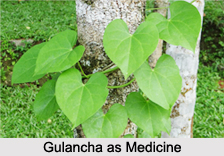 Gulancha is one such plant and among the most highly revered herbs of Ayurvedic medicine. It has also been used in traditional ayurvedic medicine in cases of dyspepsia and fevers.
Gulancha is one such plant and among the most highly revered herbs of Ayurvedic medicine. It has also been used in traditional ayurvedic medicine in cases of dyspepsia and fevers.
Health Benefits of Gulancha
The stem, leaves, roots and watery extract of this plant are all used in Hindu Medicine. The entire plant is regarded as a valuable alterative and tonic. It is used in general debility, fever, jaundice, skin diseases, rheumatism, urinary diseases, irritability of stomach, etc.
The fresh juice of the plant is taken with milk as a general tonic. In fevers it is used in a great variety of forms. Thus a cold infusion of Gulancha is given with honey in bilious fever. A decoction of Gulancha or its fresh juice is given with the addition of long pepper and honey in chronic fever with cough. A compound decoction is thus prepared. Take Gulancha, Hedyotis biflora (parparta), Cyperus rotundus (mustaka), chiretta and ginger, each one drachm, water half a seer. Boil down to one-fourth. It is said to be useful in fevers caused by deranged air and bile. Practically it is found very useful in chronic fevers, which have resisted other antiperiodics and which are apt to recur after apparent recovery. In chronic fever with loss of appetite, the following confection is recommended by many writers.
Dhatrimodaka: Take chebulic and emblic myrobalans, ginger and long pepper one part each, watery extract of gulancha 4 parts and water 16 parts. Boil till reduced to one-fourth, and prepare a confection with 8 parts of sugar. When of proper consistence divide the mass into boluses of about a drachm each. One of these is taken every morning, in chronic fever with enlarged spleen, cough, loss of appetite, etc.
Gulancha Used as Medicated Oil
Gulancha enters into the composition of a large number of prescriptions for chronic skin diseases. The juice of the plant or its decoction is given alone, or with the addition of guggulu or bdellium. Numerous compound decoctions with the addition of various other drugs such as neem, turmeric, catechu, etc. are used in these diseases, as well as in gout and rheumatism. Several oils, for external application are prepared with gulancha and are much used in skin diseases, rheumatic affections and nervous complaints.
Guduchyadi Taila: Take fresh gulancha 8 seers and water 64 seers, boil till reduced to one-fourth and strain. To the strained decoction, add prepared sesamum oil 4 seers and gulancha beaten to a paste with water one seer and boil together till the water is evaporated. This oil is a favourite application in eruptive skin diseases from impure blood. The Vrihat Guduchyadi Taila is prepared by the addition of a number of other medicines in the form of paste, to the decoction of gulancha and the oil.
Another compound oil called Vata Guduchyadi Taila is thus prepared. Take gulancha 12 seers and a half and water 64 seers. Boil till reduced to one-fourth. Take the fresh juice of Adhatoda Vasica (rasaka) and of datura leaves each 4 seers, prepared mustard oil 4 seers and aromatics in the form of paste one seer. Boil together the decoction of gulancha with the vegetable juices, oil and paste, in the usual manner. This pit is recommended by Charaka in eruptive skin diseases with troublesome itching, as also in diseases of nervous origin.
Related Articles
History of Ayurveda
Origin of Ayurveda
Ayurveda Medication
Elements of Ayurveda
Concepts of Ayurveda
Ancient Literature of Ayurveda





